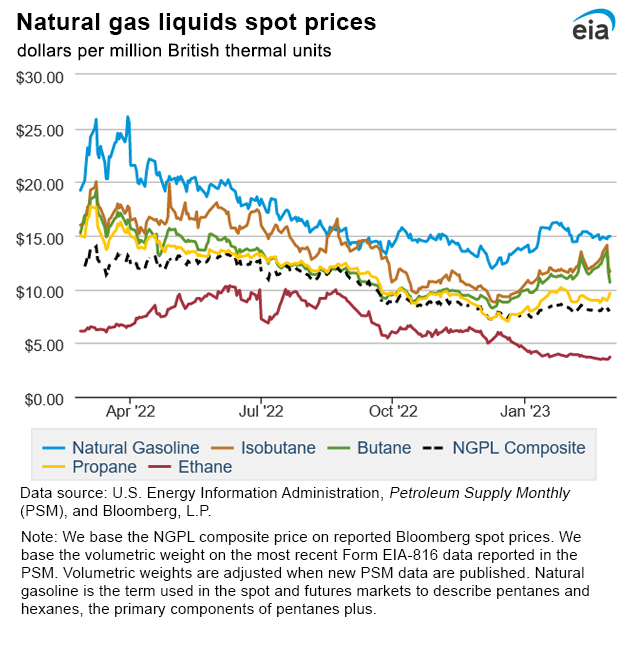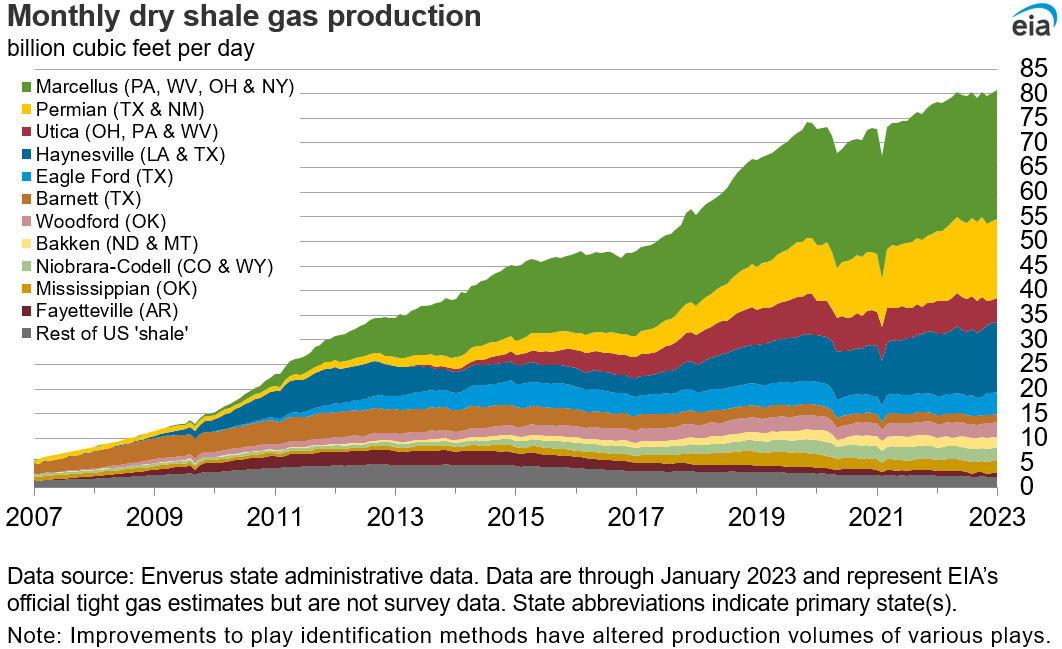In the News:
U.S. ethane demand grew 9% in 2022 driven by petrochemical capacity additions
In 2022, U.S. ethane demand increased by approximately 9%, or almost 0.2 million barrels per day (b/d), according to preliminary annual data published in our Petroleum Supply Monthly. U.S. production and consumption of ethane, a hydrocarbon gas liquid used almost exclusively as a feedstock in the petrochemical industry, has grown since 2010 along with the build-out of U.S. petrochemical capacity. More recently, international demand for ethane exported from the United States, also for use as a petrochemical feedstock, has been growing. Petrochemical plants consuming ethane use steam crackers to produce ethylene, a precursor chemical for manufacturing many plastics and resins. U.S. ethane product supplied, a proxy for ethane demand for domestic ethylene production, averaged just under 2.0 million b/d in 2022, reaching a peak of almost 2.2 million b/d in July.
Ethane prices almost doubled between January and June 2022, from approximately 37 cents per gallon (gal), or $5.65 per million British thermal units (MMBtu), to 64 cents/gal, or $9.67/MMBtu, according to Bloomberg Finance, L.P. Most petrochemical cracking capacity built in the United States since 2012 can only use ethane as a feedstock, meaning high ethane prices can reduce ethylene margins. In the third quarter of 2022 (3Q22), new ethylene crackers came online in Port Arthur, Texas, and Monaca, Pennsylvania, adding a combined 156,000 b/d of domestic ethane cracking capacity. These capacity additions follow a 108,000 b/d increase in cracker capacity in 2021. Ethane demand declined in December due to a winter storm that caused some petrochemical facilities in the Gulf Coast to be idled prior to the storm.
U.S. ethane exports rose to 447,000 b/d in 2022, up from 369,000 b/d in 2021 and 271,000 b/d in 2020, as the capacity to consume ethane as a petrochemical feedstock rose internationally. Ethane exports from the United States to China increased 50% from 2021 levels to average a record 157,000 b/d in 2022, as an additional 75,000 b/d of ethane-fed cracker capacity came online in China. The construction of new ethane tankers has facilitated higher utilization of U.S. ethane export capacity.
In our February 2023 Short-Term Energy Outlook (STEO), we forecast that domestic ethane consumption will grow slightly to just under 2.1 million b/d in 2023 and just over 2.1 million b/d in 2024, reflecting no anticipated new petrochemical cracker completions through the end of the forecast period. We forecast ethane exports to continue growing to an average of 460,000 b/d in 2023 and 490,000 b/d in 2024. Increased petrochemical capacity coming online abroad, paired with export capacity additions, is expected to drive these increases.
Market Highlights:
(For the week ending Wednesday, March 1, 2023)Prices
- Henry Hub spot price: The Henry Hub spot price rose 51 cents from $2.08 per million British thermal units (MMBtu) last Wednesday to $2.59/MMBtu yesterday.
- Henry Hub futures prices: The March 2023 NYMEX contract expired Friday at $2.451/MMBtu, up 28 cents from last Wednesday. The April 2023 NYMEX contract price increased to $2.811/MMBtu, up 51 cents from last Wednesday to yesterday. The price of the 12-month strip averaging April 2023 through March 2024 futures contracts climbed 42 cents to $3.527/MMBtu.
- Select regional spot prices: Natural gas spot prices rose at most locations this report week (Wednesday, February 22, to Wednesday, March 1), although prices declined in a few Northeast markets. Week-over-week price changes ranged from an increase of $4.19/MMBtu at PG&E Citygate to a decrease of $1.12/MMBtu at Algonquin Citygate.
- The price at PG&E Citygate in Northern California rose $4.19, up from $8.17/MMBtu last Wednesday to $12.36/MMBtu yesterday. The price at SoCal Citygate in Southern California increased $3.33 from $8.38/MMBtu last Wednesday to $11.71/MMBtu yesterday. The price at Sumas on the Canada-Washington border, the main pricing point in the Pacific Northwest, rose $2.31 from $8.36/MMBtu last Wednesday to $10.67/MMBtu yesterday. According to data from S&P Global Commodity Insights, natural gas consumption in the West increased 17%, or 2.0 billion cubic feet per day (Bcf/d), to an average of 13.7 Bcf/d this week, driven by a 23% (1.3 Bcf/d) increase in the residential and commercial sectors. Temperatures in the Riverside Area, east of Los Angeles, averaged 46°F this week, 12°F below normal, resulting in 77 more heating degree days (HDD) than normal. A rare winter storm in the middle of the report week brought snow to low-elevation areas around Los Angeles. In the Seattle City Area, temperatures averaged 36°F, which resulted in 56 more HDDs than normal.
- The FGT Citygate spot price, which reflects deliveries into Florida via the Florida Gas Transmission pipeline, increased 63 cents from $2.27/MMBtu last Wednesday to $2.90 yesterday. Temperatures in the Tampa Area averaged 74°F, resulting in 67 cooling degree days (CDD), a measure of air-conditioning demand, which was 42 more CDDs than normal. Along the Atlantic Coast, natural gas consumption in the electric power sector increased 6% (0.3 Bcf/d) week over week, according to data from S&P Global Commodity Insights, while consumption in the residential and commercial sectors declined 38% (0.6 Bcf/d).
- In the Northeast, spot natural gas price changes were mixed this week. At the Algonquin Citygate, which serves Boston-area consumers, the price went down $1.12 from $4.38/MMBtu last Wednesday to $3.26/MMBtu yesterday. At the Transcontinental Pipeline Zone 6 trading point for New York City, the price increased 48 cents from $1.98/MMBtu last Wednesday to $2.46/MMBtu yesterday. Temperatures in the Boston Area continued to be volatile this week, falling to a daily average of 17°F on February 25 and rising to an average of 38°F on March 1. Use of oil-fired electricity generation capacity in New England has been minimal this winter, although during periods of extreme cold, oil used for electricity generation increases. On February 25, oil-fired generation reached an average 8% of the electricity generation mix and returned to close to zero on February 27. In the New York-Central Park Area, temperatures averaged 37°F, resulting in 9 more HDDs than normal. Natural gas consumption in the New York and New Jersey region increased 25% (1.6 Bcf/d), led by an increase of 34% (1.5 Bcf/d) in consumption in the residential and commercial sectors.
- International futures prices: International natural gas futures prices continued to decrease this report week. According to Bloomberg Finance, L.P., weekly average front-month futures prices for liquefied natural gas (LNG) cargoes in East Asia decreased 58 cents to a weekly average of $14.76/MMBtu. Natural gas futures for delivery at the Title Transfer Facility (TTF) in the Netherlands decreased 54 cents to a weekly average of $15.10/MMBtu, the lowest level since August 2021. In the same week last year (week ending March 2, 2022), the prices in East Asia and at TTF were $32.50/MMBtu and $40.28/MMBtu, respectively.
- Natural gas plant liquids (NGPL) prices: The natural gas plant liquids composite price at Mont Belvieu, Texas, rose by 11 cents/MMBtu, averaging $8.16/MMBtu for the week ending March 1. Ethane prices fell 1%, while natural gas prices at the Houston Ship Channel rose 15% week over week, narrowing the ethane premium to natural gas by 17%. Ethylene spot prices remained relatively unchanged, and the ethylene to ethane premium also remained relatively unchanged. Brent crude oil prices rose 1%, while propane prices rose 3%, resulting in a 2% decrease in the propane discount relative to crude oil. The normal butane and isobutane prices rose 2% and 4%, respectively. The natural gasoline price fell 1%.
Daily spot prices by region are available on the EIA website.
Supply and Demand
- Supply: According to data from S&P Global Commodity Insights, the average total supply of natural gas rose by 0.6% (0.7 Bcf/d) compared with the previous report week. Dry natural gas production grew by 0.2% (0.2 Bcf/d), and average net imports from Canada increased by 8.8% (0.4 Bcf/d) from last week.
- Demand: Total U.S. consumption of natural gas rose by 3.7% (3.2 Bcf/d) compared with the previous report week, according to data from S&P Global Commodity Insights. Natural gas consumed for power generation climbed by 5.5% (1.6 Bcf/d) week over week. Industrial sector consumption remained unchanged, averaging 24.1 Bcf/d, while residential and commercial sector consumption increased by 4.7% (1.6 Bcf/d). Natural gas exports to Mexico increased 2.1% (0.1 Bcf/d). Natural gas deliveries to U.S. LNG export facilities (LNG pipeline receipts) averaged 12.7 Bcf/d, or 0.4 Bcf/d lower than last week.
Liquefied Natural Gas (LNG)
- Pipeline receipts: Overall natural gas deliveries to U.S. LNG export terminals decreased by 3.1% (0.4 Bcf/d) week over week to 12.7 Bcf/d, according to data from S&P Global Commodity Insights. Natural gas deliveries to terminals in South Louisiana decreased by 5.1% (0.5 Bcf/d) to 8.5 Bcf/d, while deliveries to Texas terminals increased by 1.9% (0.1 Bcf/d) to 3.0 Bcf/d. Natural gas deliveries to terminals along the East Coast were unchanged week over week.
- Vessels departing U.S. ports: Twenty-four LNG vessels (six from Sabine Pass; four each from Cameron and Corpus Christi; three each from Calcasieu Pass, Cove Point, and Freeport; and one from Elba Island) with a combined LNG-carrying capacity of 88 Bcf departed the United States between February 23 and March 1, according to shipping data provided by Bloomberg Finance, L.P. LNG loadings at Freeport LNG have been below the carrying capacity of LNG vessels, based on feedgas data, as the terminal resumes operations and increases LNG production.
- Vessels arriving at U.S. ports: One LNG vessel with a carrying capacity of 3 Bcf docked for off-loading at the Everett LNG terminal in Boston Harbor in Massachusetts between February 23 and March 1, according to shipping data provided by Bloomberg Finance, L.P. This delivery is the sixth to the terminal this winter heating season.
Rig Count
- According to Baker Hughes, for the week ending Tuesday, February 21, the natural gas rig count remained unchanged from a week ago at 151 rigs, as the Permian added 2 rigs and the Haynesville dropped 2 rigs. The number of oil-directed rigs decreased by 7 from a week ago to 600 rigs. The Ardmore Woodford and Cana Woodford each added one rig; the Arkoma Woodford, DJ-Niobrara, and Permian each dropped one rig, the Granite Wash dropped two rigs, and four rigs were dropped in unidentified producing regions. The total rig count, which includes 2 miscellaneous rigs, stands at 753, 103 more rigs than last year at this time.
Storage
- Net withdrawals from storage totaled 81 Bcf for the week ending February 24, compared with the five-year (2018–2022) average net withdrawals of 134 Bcf and last year's net withdrawals of 137 Bcf during the same week. Working natural gas stocks totaled 2,114 Bcf, which is 342 Bcf (19%) more than the five-year average and 451 Bcf (27%) more than last year at this time.
- According to The Desk survey of natural gas analysts, estimates of the weekly net change to working natural gas stocks ranged from net withdrawals of 65 Bcf to 88 Bcf, with a median estimate of 78 Bcf.
- The average rate of withdrawals from storage is 24% lower than the five-year average so far in the withdrawal season (November through March). If the rate of withdrawals from storage matched the five-year average of 6.9 Bcf/d for the remainder of the withdrawal season, the total inventory would be 1,874 Bcf on March 31, which is 342 Bcf higher than the five-year average of 1,532 Bcf for that time of year.
See also:
Top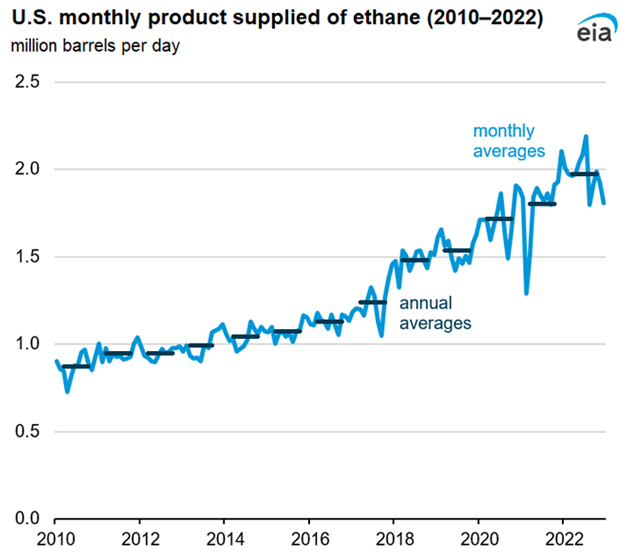
Data source: U.S. Energy Information Administration, Petroleum Supply Monthly
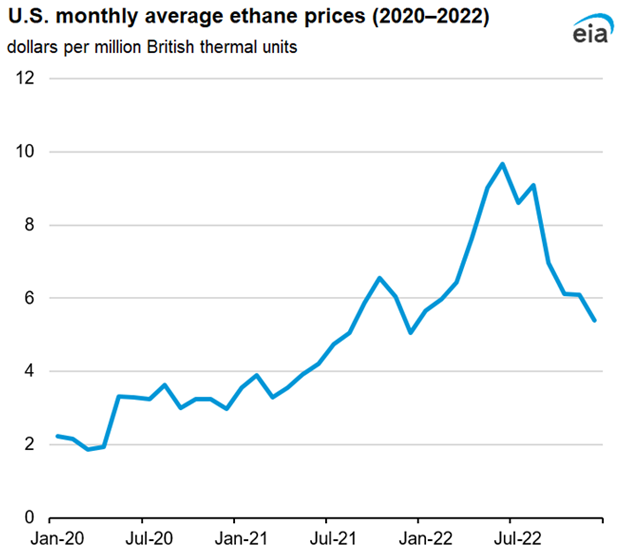
Data source: Bloomberg, L.P.
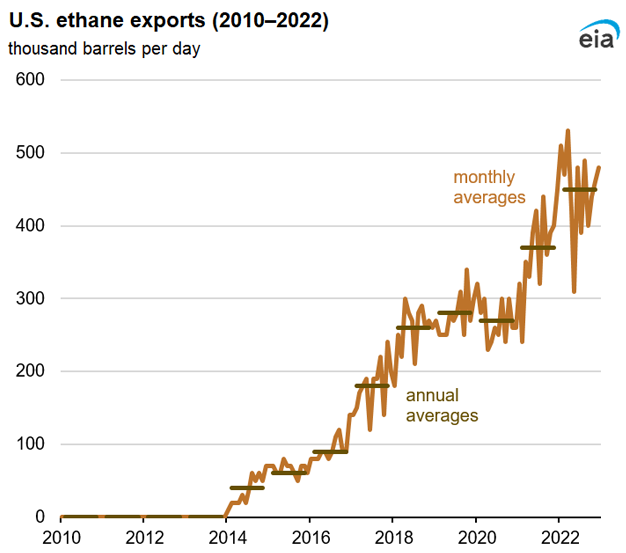
Data source: U.S. Energy Information Administration, Short-Term Energy Outlook
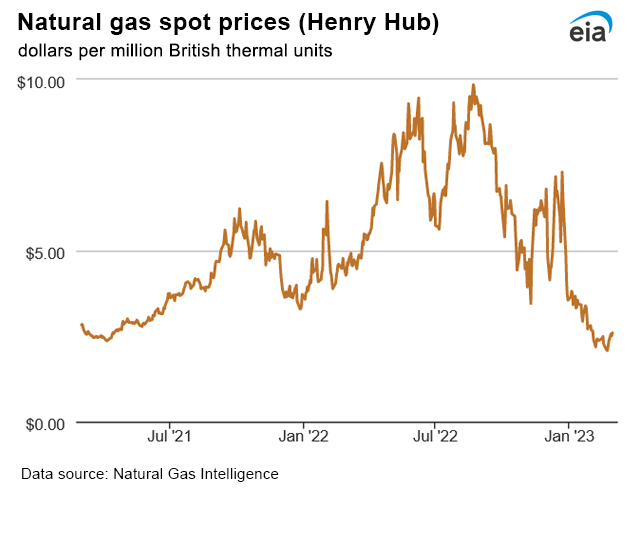
| Spot Prices ($/MMBtu) | Thu, 23-Feb |
Fri, 24-Feb |
Mon, 27-Feb |
Tue, 28-Feb |
Wed, 01-Mar |
|---|---|---|---|---|---|
| Henry Hub | 2.19 | 2.35 | 2.56 | 2.51 | 2.59 |
| New York | 2.38 | 2.58 | 2.51 | 2.44 | 2.46 |
| Chicago | 2.28 | 2.22 | 2.40 | 2.43 | 2.53 |
| Cal. Comp. Avg.* | 13.73 | 11.91 | 7.40 | 8.55 | 11.39 |
| Futures ($/MMBtu) | |||||
| March Contract | 2.314 | 2.451 | Expired | Expired | Expired |
| April Contract | 2.432 | 2.548 | 2.731 | 2.747 | 2.811 |
| May Contract | 2.590 | 2.701 | 2.853 | 2.863 | 2.943 |
| Data source: Natural Gas Intelligence and CME Group as compiled by Bloomberg, L.P. | |||||
| *Avg. of NGI's reported prices for: Malin, PG&E Citygate, and Southern California Border Avg. | |||||
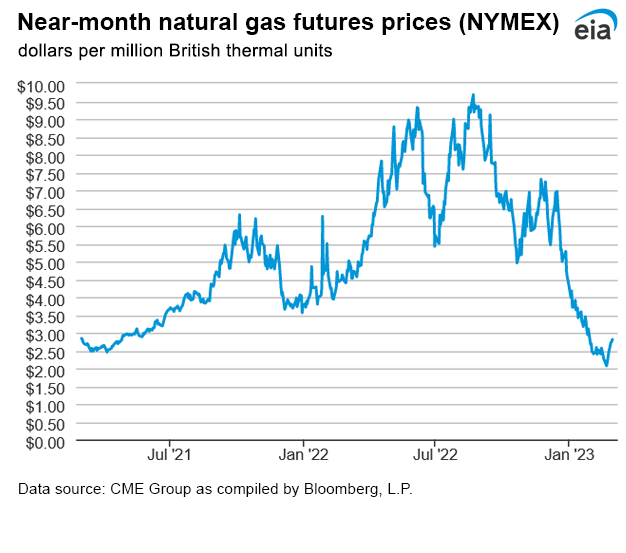
| U.S. natural gas supply - Gas Week: (2/23/23 - 3/1/23) | |||
|---|---|---|---|
Average daily values (billion cubic feet) |
|||
this week |
last week |
last year |
|
| Marketed production | 113.1 |
112.8 |
105.9 |
| Dry production | 100.7 |
100.5 |
93.8 |
| Net Canada imports | 5.0 |
4.6 |
6.0 |
| LNG pipeline deliveries | 0.1 |
0.1 |
0.2 |
| Total supply | 105.9 |
105.2 |
100.0 |
|
Data source: S&P Global Commodity Insights | |||
| U.S. natural gas consumption - Gas Week: (2/23/23 - 3/1/23) | |||
|---|---|---|---|
Average daily values (billion cubic feet) |
|||
this week |
last week |
last year |
|
| U.S. consumption | 91.6 |
88.4 |
102.3 |
| Power | 31.6 |
29.9 |
31.1 |
| Industrial | 24.1 |
24.1 |
25.6 |
| Residential/commercial | 36.0 |
34.4 |
45.6 |
| Mexico exports | 5.4 |
5.2 |
5.8 |
| Pipeline fuel use/losses | 7.4 |
7.3 |
7.5 |
| LNG pipeline receipts | 12.7 |
13.1 |
11.9 |
| Total demand | 117.1 |
114.1 |
127.5 |
|
Data source: S&P Global Commodity Insights | |||
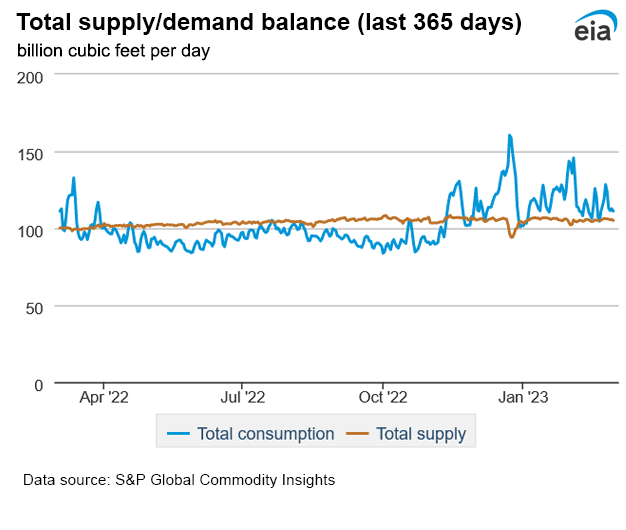
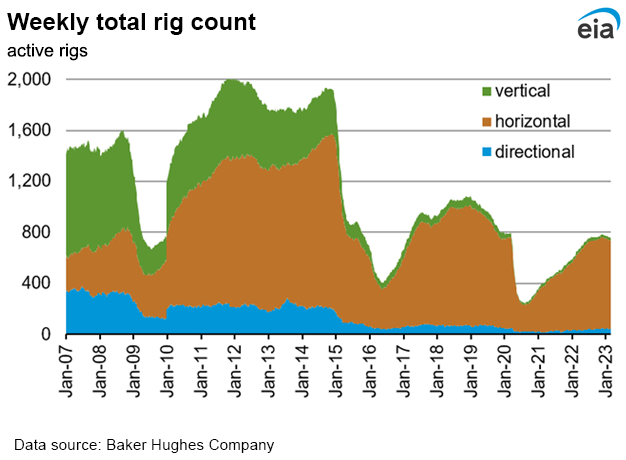
| Rigs | |||
|---|---|---|---|
Tue, February 21, 2023 |
Change from |
||
last week |
last year |
||
| Oil rigs | 600 |
-1.2% |
14.9% |
| Natural gas rigs | 151 |
0.0% |
18.9% |
| Note: Excludes any miscellaneous rigs | |||
| Rig numbers by type | |||
|---|---|---|---|
Tue, February 21, 2023 |
Change from |
||
last week |
last year |
||
| Vertical | 16 |
-11.1% |
-38.5% |
| Horizontal | 693 |
-1.0% |
16.9% |
| Directional | 44 |
4.8% |
41.9% |
| Data source: Baker Hughes Company | |||
| Working gas in underground storage | ||||
|---|---|---|---|---|
Stocks billion cubic feet (Bcf) |
||||
| Region | 2023-02-24 |
2023-02-17 |
change |
|
| East | 451 |
479 |
-28 |
|
| Midwest | 544 |
575 |
-31 |
|
| Mountain | 99 |
106 |
-7 |
|
| Pacific | 99 |
108 |
-9 |
|
| South Central | 922 |
926 |
-4 |
|
| Total | 2,114 |
2,195 |
-81 |
|
| Data source: U.S. Energy Information Administration Form EIA-912, Weekly Underground Natural Gas Storage Report | ||||
| Working gas in underground storage | |||||
|---|---|---|---|---|---|
Historical comparisons |
|||||
Year ago (2/24/22) |
5-year average (2018-2022) |
||||
| Region | Stocks (Bcf) |
% change |
Stocks (Bcf) |
% change |
|
| East | 363 |
24.2 |
390 |
15.6 |
|
| Midwest | 411 |
32.4 |
446 |
22.0 |
|
| Mountain | 97 |
2.1 |
100 |
-1.0 |
|
| Pacific | 166 |
-40.4 |
176 |
-43.8 |
|
| South Central | 625 |
47.5 |
660 |
39.7 |
|
| Total | 1,663 |
27.1 |
1,772 |
19.3 |
|
| Data source: U.S. Energy Information Administration Form EIA-912, Weekly Underground Natural Gas Storage Report | |||||
| Temperature – heating & cooling degree days (week ending Feb 23) | ||||||||
|---|---|---|---|---|---|---|---|---|
HDDs |
CDDs |
|||||||
| Region | Current total |
Deviation from normal |
Deviation from last year |
Current total |
Deviation from normal |
Deviation from last year |
||
| New England | 199 |
-51 |
11 |
0 |
0 |
0 |
||
| Middle Atlantic | 178 |
-60 |
-6 |
0 |
0 |
0 |
||
| E N Central | 209 |
-46 |
-31 |
0 |
0 |
0 |
||
| W N Central | 264 |
8 |
-32 |
0 |
0 |
0 |
||
| South Atlantic | 88 |
-64 |
-16 |
16 |
8 |
2 |
||
| E S Central | 94 |
-54 |
-27 |
8 |
6 |
7 |
||
| W S Central | 78 |
-20 |
-19 |
14 |
10 |
5 |
||
| Mountain | 232 |
40 |
6 |
0 |
-1 |
0 |
||
| Pacific | 137 |
37 |
13 |
0 |
-1 |
0 |
||
| United States | 167 |
-23 |
-13 |
5 |
2 |
1 |
||
|
Data source: National Oceanic and Atmospheric Administration Note: HDDs=heating degree days; CDDs=cooling degree days | ||||||||
Average temperature (°F)
7-day mean ending Feb 23, 2023
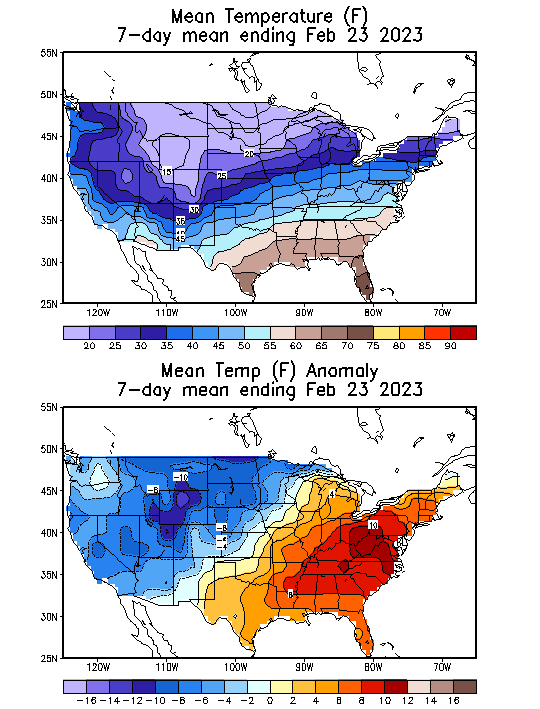
Data source: National Oceanic and Atmospheric Administration
Deviation between average and normal temperature (°F)
7-day mean ending Feb 23, 2023

Data source: National Oceanic and Atmospheric Administration

